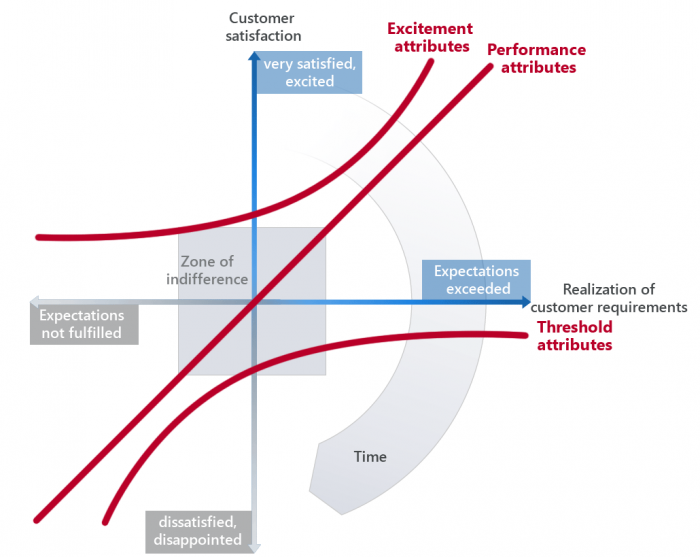
What is the relationship between customer satisfaction and the characteristics of products or services?

The Kano Model describes the connection between the realization of customer requirements and customer satisfaction. It is not possible to deduce an overall satisfaction level from the Kano Model. Different customer requirements are indicated by different lines.
Excitement attributes are not expected by (potential) customers. Existing excitement attributes can lead to disproportionate satisfaction.
Performance attributes are explicitely requested by customers and have direct impact on satisfaction or dissatisfaction. Example: High fuel consumption - dissatisfied customer; low fuel consumption - satisfied customer.
The zone of indifference indicates an area in which expectations in requirements are more or less fulfilled. Outside the zone satisfaction and dissatisfaction respectively increase disproportionally.
Threshold attributes are taken for granted; customers become aware of them only if they are missing. The have no effect on satisfaction levels but can cause dissatisfaction if missing. Example: passenger-side airbag.
Over time, excitement attributes become performance attributes and subsequently threshold attributes. A good example is mobile technology or IT.
The Kano Model describes the connection between customer satisfaction and the realization of customer requirements. Noriaki Kano, professor (emeritus) of Tokyo University of Science, developed a model for customer satisfacton in 1978, known today as the Kano Model. He determined 5 characteristics of customer requirements:
Threshold attributes (Must-be qualities). These attributes are taken for granted when fulfilled but result in dissatisfaction when not fulfilled. Customers expect these attributes and view them as basic; it is unlikely that they are going to tell the company about them when asked about quality attributes.
Performance attributes (One-dimensional qualities). These attributes result in satisfaction when fulfilled and dissatisfaction when not fulfilled. These are attributes that are spoken and the ones in which companies compete. If they are excelled customer satisfaction increases accordingly.
Excitement attributes (Attractive qualities). These attributes provide satisfaction when achieved but do not cause dissatisfaction when not fulfilled. They are not normally expected and thus often unspoken.
Indifferent qualities. These aspects are neither good or bad and have no effect, positive or negative, on customer satisfaction.
Reverse qualities. If these aspects exist they lead to dissatisfaction; if they do not exist they do not lead to satisfaction.
The Kano Model originates from the two-factor theory by Frederick Herzberg. It states that there are certain factors in the workplace that cause job satisfaction, while a separate set of factors causes dissatisfaction. The two-factor theory distinguishes between motivators and hygiene factors; according to Herzberg, hygiene factors are what cause dissatisfaction among employees in a workplace.
In order to remove dissatisfaction in a work environment, these hygiene factors must be eliminated. Eliminating dissatisfaction is only one half of the task of the two factor theory. The other half is to increase satisfaction in the workplace. This can be done by improving on motivating factors.
The must-be qualities of Kano correspond to the hygiene factors of Herzberg. The one-dimensional and attractive qualities correspond to the motivating factors.
Customer expectations for characteristics and features of products, systems, solutions and software vary greatly. One feature may excite a customer while another person may take it for granted or even reject a product because of it. Thus, examples are not generally accepted.
Excitement attributes: Online access via TV, paying via smartphone
Performance attributes: Display resolution, battery life of smart phones
Threshold attributes: Customizable ring tones, TV channel search
Indifferent qualities: Adding emoticons to instant messaging apps, Capacity of more than 1000 stations in TVs
Reverse qualities: Displaying apps when changing channels, rust on motorcycle wheel rims